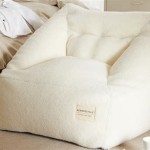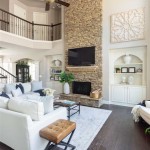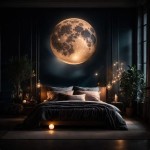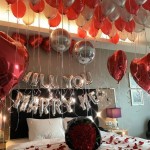How To Decorate a Victorian Home
Decorating a Victorian home involves balancing historical accuracy with modern functionality. This style, prevalent from the mid-to-late 19th century, emphasizes ornate details, rich colors, and a sense of layered opulence. Understanding the key elements allows homeowners to capture the Victorian spirit while adapting it to contemporary living.
Color Palettes: Authentic Victorian color schemes often feature deep, saturated hues. Jewel tones like ruby red, emerald green, sapphire blue, and amethyst purple are common. These are often paired with lighter, contrasting shades such as cream, ivory, or pale gold. Muted shades like sage green, mustard yellow, and dusty rose also reflect the era's aesthetic. Consider using a combination of these rich and muted tones to create depth and visual interest.
Wallpaper: Wallpaper is a hallmark of Victorian decor. Period-appropriate patterns include intricate floral designs, damasks, and geometric motifs. Consider using wallpaper on a single accent wall, in a hallway, or even on the ceiling to create a focal point. Reproduction Victorian wallpapers are readily available, offering historically accurate designs. Modern interpretations of these patterns can also create a nod to the era while maintaining a contemporary feel.
Textiles: Layering textiles adds to the luxurious feel of a Victorian interior. Heavy drapes in velvet, brocade, or damask are characteristic. These can be complemented by lace curtains or sheers for added privacy and light control. Incorporate decorative pillows and throws featuring tassels, fringe, and embroidery to further enhance the space. Upholstered furniture in rich fabrics such as velvet, leather, or tapestry contributes to the overall opulence.
Furniture: Victorian furniture is typically characterized by dark wood, intricate carvings, and plush upholstery. Common pieces include chaise lounges, settees, button-tufted armchairs, and elaborately carved dining tables. When selecting furniture, consider pieces made from mahogany, walnut, or rosewood. Antique stores and auction houses can be excellent resources for finding original Victorian furniture. Replicas are also available, offering a more budget-friendly option.
Architectural Details: High ceilings, ornate moldings, and large windows are common features of Victorian architecture. Emphasize these features by restoring original woodwork and adding decorative ceiling medallions. Stained glass windows, either original or reproductions, are another hallmark of the era. If original stained glass is not feasible, consider using decorative window films to mimic the look.
Lighting: Lighting plays a crucial role in creating the desired ambiance. Chandeliers, wall sconces, and table lamps with intricate metalwork and glass shades are characteristic of the Victorian era. Consider using warm-toned light bulbs to create a soft, inviting glow. Placement of lighting fixtures should be strategically considered to highlight architectural features and artwork.
Accessories: Accessories are essential for completing the Victorian look. Incorporate decorative items such as porcelain figurines, antique clocks, silver trays, and framed artwork. Mirrors in ornate frames can help to enhance natural light and create a sense of spaciousness. Collections of books, antique scientific instruments, or other objects of interest can be displayed in glass-fronted cabinets or on open shelves.
Flooring: Original Victorian homes often featured wood floors. Restoring these floors and adding area rugs in rich patterns and textures enhances the period aesthetic. If original flooring is not an option, consider using wood-look flooring or patterned carpets reminiscent of the era. Layering rugs can create visual interest and define different areas within a room.
Artwork: Victorian-era artwork often featured landscapes, portraits, and still life paintings. Consider framing prints of period artwork or incorporating original pieces if possible. Antique maps, botanical prints, and framed needlepoint samplers are other options for adding visual interest and reflecting the era’s aesthetic. Gallery walls, featuring a mix of framed artwork and photographs, can create a focal point and add a personal touch.
Balancing Authenticity with Modernity: While striving for historical accuracy is admirable, it's important to adapt the Victorian style to suit modern lifestyles. Consider incorporating modern conveniences while maintaining the overall aesthetic. For example, updated appliances can be seamlessly integrated into a Victorian kitchen by choosing models with vintage-inspired designs. Similarly, modern bathroom fixtures can be paired with period-appropriate tiling and lighting to create a cohesive look.
Research and Inspiration: Before embarking on a Victorian decorating project, research the era thoroughly. Visiting historic Victorian homes, browsing period design books, and consulting with architectural historians can provide valuable insights and inspiration. This research will help homeowners to make informed decisions about color palettes, furniture choices, and decorative elements, ensuring that the final result is a harmonious and authentic representation of the Victorian style.
:max_bytes(150000):strip_icc()/ScreenShot2021-08-18at3.46.48PM-0881e8625a754c1a94a611f3e74a6226.png?strip=all)
27 Modern Victorian Decorating Ideas That Aren T Stuffy
:max_bytes(150000):strip_icc()/alaina-kaczmarski-home-living-1-9b10209fb438487789b81418ed595c2c.jpg?strip=all)
How To Do Victorian Interior Decor The Sophisticated Way

Victorian Interior Design Style History And How To Create A Modern Decorator New Jersey

Modern Victorian Decorating Ideas Cb2 Idea Central

9 Best Victorian Interior Design Ideas To Beautify Your Home Foyr

Victorian Interior Design Style History And How To Create A Modern Decorator New Jersey

The Ultimate Guide To Victorian Decor

5 Crucial Elements Of Victorian Style Qualitybath Com Discover

Feast For The Senses 25 Vivacious Victorian Living Rooms Decoist

Feast For The Senses 25 Vivacious Victorian Living Rooms Decoist







